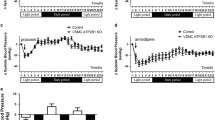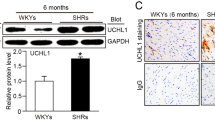Abstract
ATP-sensitive potassium (KATP) channels are participants of mechanisms of pathological myocardial remodeling containment. The aim of our work was to find the association of changes in the expression of Kir6.1, Kir6.2, SUR1, and SUR2 subunits of KATP channels with changes in heart function and structure during aging under conditions of the constant increase of vascular pressure. The experiments were carried out on young and old spontaneously hypertensive rats (SHR) and Wistar rats. The expression levels of KATP channels subunits were determined using reverse transcription and quantitative PCR. It is shown that the mRNA expression level of Kir6.1 in young SHR rats is significantly lower (6.3-fold, p = 0.035) than that of young Wistar rats that may be one of the causes of arterial hypertension in SHR. At the same time, mRNA expression of both Kir6.1 and Kir6.2 in old SHR rats was significantly higher (6.8-fold, p = 0.003, and 5.9-fold, p = 0.006, respectively) than in young hypertensive animals. In both groups of old animals, SUR2 expression was significantly reduced compared to young animals, in Wistar rats at 3.87-fold (p = 0.028) and in SHR rats at 48.2-fold (p = 0.033). Changes in SUR1 expression were not significant. Thus, significant changes in the cardiovascular system, including impaired function and structure of the heart in old SHR rats, were associated with a significant decrease in SUR2 expression that may be one of the mechanisms of heart failure decompensation. Therefore, it can be assumed that increased expression of SUR2 may be one of the protective mechanisms against pathological myocardial remodeling.

Similar content being viewed by others
References
Nichols CG (2006) KATP channels as molecular sensors of cellular metabolism. Nature 440(7083):470–476
Olson TM, Terzic A (2010) Human KATP channelopathies: diseases of metabolic homeostasis. Pflugers Arch 460(2):295–306
Du Q, Jovanović S, Clelland A, Sukhodub A, Budas G, Phelan K et al (2006) Overexpression of SUR2A generates a cardiac phenotype resistant to ischemia. FASEB J 20(8):1131–1141
Crawford RM, Jovanović S, Budas GR, Davies AM, Lad H, Wenger RH et al (2003) Chronic mild hypoxia protects heart-derived H9c2 cells against acute hypoxia/reoxygenation by regulating expression of the SUR2A subunit of the ATP-sensitive K+ channel. J Biol Chem 278(33):31444–31455
Mohammed Abdul KS, Jovanović S, Sukhodub A, Du Q, Jovanović A (2014) Upregulation of cardioprotective SUR2A by sub-hypoxic drop in oxygen. Biochim Biophys Acta 1843(11):2424–2431
Budas GR, Jovanovic S, Crawford RM, Jovanovic A (2004) Hypoxia-induced preconditioning in adult stimulated cardiomyocytes is mediated by the opening and trafficking of sarcolemmal KATP channels. FASEB J 18(9):1046–1048
Kane GC, Behfar A, Dyer RB, O’Cochlain DF, Liu XK, Hodgson DM et al (2006) KCNJ11 gene knockout of the Kir6.2 KATP channel causes maladaptive remodeling and heart failure in hypertension. Hum Mol Genet 15(15):2285–97
Tocci G, Sciarretta S, Volpe M (2008) Development of heart failure in recent hypertension trials. J Hypertens 26:1477–1486
Yamada S, Kane GC, Behfar A, Liu XK, Dyer RB, Faustino RS, Miki T et al (2006) Protection conferred by myocardial ATP-sensitive K+ channels in pressure overload-induced congestive heart failure revealed in KCNJ11 Kir6.2-null mutant. J Physiol 577(Pt 3):1053–65
Strutynskyi RB, Voronkov LG, Nagibin VS, Mazur ID, Stroy D, Dosenko VE (2018) Changes of the echocardiographic parameters in chronic heart failure patients with Ile337val, Glu23lys, and Ser1369ala polymorphisms of genes encoding the ATP-sensitive potassium channels subunits in the Ukrainian population. Ann Hum Genet 82(5):272–279
Blanco-Rivero J, Gamallo C, Aras-López R, Cobeño L, Cogolludo A, Pérez-Vizcaino F, Ferrer M, Balfagon G (2008) Decreased expression of aortic KIR61 and SUR2B in hypertension does not correlate with changes in the functional role of K(ATP) channels. Eur J Pharmacol 587(1–3):204–8
Sun Y, Huang Y, Zhang R, Chen Q, Chen J, Zong Y, Liu J, Feng S, Liu AD, Holmberg L, Liu D, Tang C, Du J, Jin H (2015) Hydrogen sulfide upregulates KATP channel expression in vascular smooth muscle cells of spontaneously hypertensive rats. J Mol Med (Berl) 93(4):439–455
Liu X, Duan P, Xingxing Hu, Li R, Zhu Q (2016) Altered KATP channel subunits expression and vascular reactivity in spontaneously hypertensive rats with age. J Cardiovasc Pharmacol 68(2):143–149
Gao M, Xue H, Wang Y, Wang H (2005) Iptakalim, opener of K(ATP), reverses the enhanced expression of genes encoding K(ATP) subunits in spontaneously hypertensive rats. Life Sci 77(22):2743–2751
Lapikova-Bryhinska T, Zhukovska A, Nagibin V, Tumanovska L, Portnichenko G, Goncharov S et al (2019) Altered biogenesis of microRNA-1 is associated with cardiac dysfunction in aging of spontaneously hypertensive rats. Mol Cell Biochem 459(1–2):73–82
Tinker A, Aziz Q, Li Y, Specterman M (2018) atp-sensitive potassium channels and their physiological and pathophysiological roles. Compr Physiol 8(4):1463–1511
Nichols CG, Singh GK, Grange DK (2013) KATP channels and cardiovascular disease: suddenly a syndrome. Circ Res 112(7):1059–1072
Foster MN, Coetzee WA (2016) katp channels in the cardiovascular system. Physiol Rev 96(1):177–252
Flagg TP, Kurata HT, Masia R, Caputa G, Magnuson MA, Lefer DJ et al (2008) Differential structure of atrial and ventricular KATP: atrial KATP channels require SUR1. Circ Res 103:1458–1465
Glukhov AV, Flagg TP, Fedorov VV, Efimov IR, Nichols CG (2009) Differential K(ATP) channel pharmacology in intact mouse heart. J Mol Cell Cardiol 48:152–160
Fukuzaki K, Sato T, Miki T, Seino S, Nakaya H (2008) Role of sarcolemmal ATP-sensitive K+ channels in the regulation of sinoatrial node automaticity: an evaluation using Kir6.2-deficient mice. J Physiol 586:2767–2778
Han X, Light PE, Giles WR, French RJ (1996) Identification and properties Of an ATP-sensitive K+ current in rabbit sino-atrial node pacemaker cells. J Physiol 490:337–350
Foster DB, Ho AS, Rucker JJ, Garlid AO, Chen L, Sidor A et al (2012) Mitochondrial ROMK channel is a molecular component of MitoKATP. Circ Res 111:446–454
Quesada I, Rovira JM, Martin F, Roche E, Nadal A, Soria B (2002) Nuclear KATP channels trigger nuclear Ca2+ transients that modulate nuclear function. Proc Natl Acad Sci USA 99(14):9544–9549
Salari S, Ghasemi M, Fahanik-Babaei J, Saghiri R, Sauve R, Eliassi A (2015) Evidence for a KATP channel in rough endoplasmic reticulum (rerKATP Channel) of rat hepatocytes. PLoS ONE 10(5):e0125798
Nilius B, Droogmans G (2001) Ion channels and their functional role in vascular endothelium. Physiol Rev 81:1415–1459
Aziz Q, Thomas AM, Gomes J, Ang R, Sones WR, Li Y et al (2014) The ATP-sensitive potassium channel subunit, Kir6.1, in vascular smooth muscle plays a major role in blood pressure control. Hypertension 64:523–529
Chutkow WA, Pu J, Wheeler MT, Wada T, Makielski JC, Burant CF et al (2002) Episodic coronary artery vasospasm and hypertension develop in the absence of Sur2 K(ATP) channels. J Clin Invest 110(2):203–208
Miki T, Suzuki M, Shibasaki T, Uemura H, Sato T, Yamaguchi K, Koseki H, Iwanaga T, Nakaya H, Seino S (2002) Mouse model of Prinzmetal angina by disruption of the inward rectifier Kir6.1. Nat Med 20028(5):466–472
Wei-Wei SH, Yang YA, Yun SH, Chun JI (2012) K(ATP) channel action in vascular tone regulation: from genetics to diseases. Sheng Li Xue Bao 64(1):1–13
Bienengraeber M, Olson TM, Selivanov VA, Kathmann EC, O’Cochlain F, Gao F et al (2004) ABCC9 mutations identified in human dilated cardiomyopathy disrupt catalytic KATP channel gating. Nat Genet 36(4):382–387
Kane GC, Liu XK, Yamada S, Olson TM, Terzic A (2005) Cardiac KATP channels in health and disease. J Mol Cell Cardiol 38(6):937–943
Lee TM, Lin MS, Chang NC (2008) Effect of ATP-sensitive potassium channel agonists on ventricular remodeling in healed rat infarcts. J Am Coll Cardiol 51(13):1309–1318
Funding
This work was performed with the financial support of the National Research Foundation of Ukraine, Project No. 2020.01/0204.
Author information
Authors and Affiliations
Contributions
RBS—Conceptualization, Methodology, Resources, Investigation. SVG—Methodology, Investigation. LVT—Methodology, Investigation. VSN—Methodology, Formal analysis, Data Curation, Writing—Original Draft. VED—Conceptualization, Methodology, Resources, Data Curation, Supervision.
Corresponding author
Ethics declarations
Conflict of interest
The authors declare they have no financial interests. All authors certify that they have no affiliations with or involvement in any organization or entity with any financial interest or non-financial interest in the subject matter or materials discussed in this manuscript. All the authors declared that that they no conflict of interest.
Ethical approval
No human studies were carried out by the authors for this article. This article does not contain any studies with human participants performed by any of the authors.
Research involving human and animal rights
All the authors of this manuscript consider that all of the manipulations with laboratory animals were performed in accordance with the European Convention for the Protection of Vertebrate Animals when used for Experimental and Other Scientific Purposes (Strasbourg, 1986). The experimental protocols were approved by the Biomedical Ethics Committee of the Bogomoletz Institute of Physiology National Academy of Sciences of Ukraine, Ukraine (No. 3/17, November 7, 2017).
Additional information
Publisher's Note
Springer Nature remains neutral with regard to jurisdictional claims in published maps and institutional affiliations.
Rights and permissions
About this article
Cite this article
Strutynskyi, R.B., Goncharov, S.V., Tumanovska, L.V. et al. Cardiac dysfunction in spontaneously hypertensive old rats is associated with a significant decrease of SUR2 expression. Mol Cell Biochem 476, 4343–4349 (2021). https://doi.org/10.1007/s11010-021-04237-8
Received:
Accepted:
Published:
Issue Date:
DOI: https://doi.org/10.1007/s11010-021-04237-8




